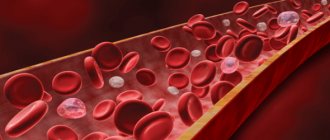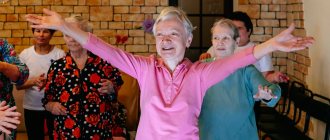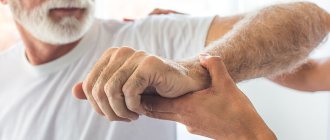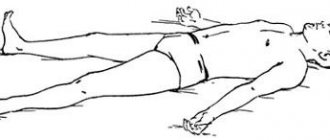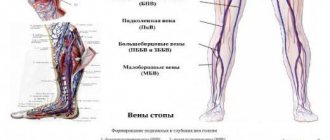Theoretical (lecture) lesson No. 15
PM 02. Participation in diagnostic, treatment and rehabilitation processes
MDK 02.01 “Nursing care for various diseases and conditions.”
Section 3 “Nursing care in pediatrics”
Specialty 34.02.01 “Nursing”
Group: 31 MOZ
Teacher: Chekho O.I.
Topic: Nursing care for heart defects and SIDS in children.
Lesson plan:
Congenital heart defects. Definition. Classification. Etiology. Pathogenesis, pathological anatomy. Clinical picture, clinical features, complications in different age groups. Methods of clinical, laboratory and instrumental examination. Basic principles of treatment. Features of nursing care. Prevention.
Sudden infant death syndrome (SIDS). Basic concepts Definition. Causes (risk factors). Pathogenesis. Clinical picture. Parental support. Prevention.
Basic summary
Congenital heart defect
- a disease of the heart valves, in which the organ begins to malfunction. As a result of a congenital change in the structure of the valve apparatus, cardiac septa, walls, or large vessels extending from the heart, a disturbance in the blood flow of the heart occurs. The disease may progress. In some cases, death is possible.
Congenital heart defects occur with a frequency of 6-8 cases per thousand births, which is 30% of all developmental defects. They rank first in mortality of newborns and children of the first year of life. After the first year of life, mortality decreases sharply, and no more than 5% of children die between the ages of 1 and 15 years.
The earlier a congenital heart defect is detected, the greater the hope for its timely treatment.
Possible complications of the disease due to improper care of seriously ill patients
Improper patient care can lead to serious consequences - a deterioration in the patient’s general well-being, progression of the disease, the onset of depression and even death.
Most often in therapeutic practice, inadequate care for seriously ill patients can have the following consequences:
1. The occurrence of contracture (limitation of joints in movement) . Often seriously ill patients do not have the physical ability to walk. This affects the joints, which without warming up begin to degenerate. To avoid this, you need to place special pillows under the patient's body. In addition, it is necessary to regularly conduct examinations, do professional massages and kneading of the limbs.
2. Formation of bedsores . This pathology often occurs in cases where a seriously ill patient is constantly in one position, as well as with insufficient hygienic care. To avoid such a problem, it is necessary to constantly examine the patient, change the position of the body, and treat areas of the body with special ointments and creams.
3. Infectious processes in the lungs (in particular, pneumonia) . A recumbent lifestyle leads to air stagnation in the lungs. It is necessary to ensure an adequate level of ventilation in the room and carry out wet cleaning daily. If these rules are not followed, pneumonia occurs, which is extremely difficult to treat. If treatment is not timely, the risk of death is very high. Special breathing exercises are used as prevention.
4. Bruises, injuries . When caring for a seriously ill patient, it is important to ensure changes in body position. But when transferring a patient to a bed, cases often occur when the patient simply falls. This leads to unpleasant injuries. To avoid such a nuisance, you must be able to correctly shift the patient, as well as equip the bed with special handrails and supports.
5. Problems while eating . Severely ill patients also have problems swallowing. If fed incorrectly, they may simply choke. In order to avoid the problem, it is necessary to introduce soft food into the diet, giving it in small portions.
Only a person who is well versed in physiology and has good medical knowledge can provide proper care for a seriously ill patient.
Symptoms
- Blue or cyanotic color of the skin, lips, ears.
- The appearance of bluish skin during breastfeeding or the baby’s cry.
- Pallor of the skin and coldness of the extremities (with “pale defects”).
- Heart murmurs.
- Signs of heart failure.
- Changes in the electrocardiogram, x-rays, echocardiographic examination (ultrasound of the heart).
Sudden infant death syndrome (SIDS) is the most common cause of death in infants aged 2 weeks to 1 year and accounts for 35–55% of all deaths in this age group.
“Death in the cradle” - sudden infant death syndrome (SIDS) is characterized by breathing disturbances during sleep, it happens completely unexpectedly for parents, without any reason visible to them, at night or in the early morning.
The peak incidence is between the 2nd and 4th months of life.
In the Arkhangelsk region, over the past 5 years, 38 children have died from this syndrome at home among children under 12 months of age. It has been proven that SIDS is 36% less common among children who have ever been breastfed. Social risk factors for SIDS: • sleeping at night in the same bed with parents, including while intoxicated, • “passive” smoking for the child - smoking of his mother, father, • mother’s refusal to exclusively breastfeed in the first six months of the child’s life, • independent transfer of the mother to feeding the child with artificial formula or cow's milk, • mothers with many children, • mothers raising children without fathers, • mothers previously deprived of parental rights to older children; • young mothers aged 16-20 years, • low level of education of parents, • poor living conditions of the family, stove heating, • mothers going to work and leaving the infant at night with fathers, grandmothers, and older children; • bathing an infant in a bathhouse. Gender risk factors for SIDS: • male gender of the child. Psychological risk factors for SIDS: • night sleep of an infant in the same bed with a tired mother, • a child born from an unplanned pregnancy, • an unwanted child, • insufficient psychological, emotional attention of the mother to the child, • insufficient attention of family members to the mother of the infant, to the mother who is breastfeeding. Medical risk factors for SIDS: • premature birth and birth of a child weighing less than 2.9 kg;
• previous abortions, miscarriages, stillbirths, • maternal illnesses during pregnancy, including sexually transmitted infections. Main literature:
Tulchinskaya V.D.. Nursing care in pediatrics: textbook / Rostov n/D: Phoenix, 2021. - Pages 238-242
Classification of principles of care for seriously ill patients
In medical practice, the methodology for caring for seriously ill patients can be divided into 2 main groups:
- General care is measures aimed at maintaining an adequate standard of living and functioning of the patient’s body.
- Special care is measures selected based on the specifics of the disease and its course.
General care includes ensuring proper hygiene, regular cleaning of the premises, monitoring the psychological state of the seriously ill person, organizing leisure activities, and others.
Special care may include the selection of the optimal menu, special physical therapy for, for example, a stroke.
It is worth noting: in order to achieve improvement in the well-being of a seriously ill patient, it is necessary to carry out a whole range of measures. This is not only proper care, but also taking medications and regular examination by a doctor.
Rules for caring for seriously ill patients
First of all, the procedure for caring for a seriously ill patient must be drawn up and adjusted depending on the condition and characteristics of the disease. But there are a number of criteria that must be met regardless of the above factors:
Requirements for the room where the patient is located The patient will spend most of his time in this room, so everything possible must be done to achieve optimal and psychologically comfortable conditions.
First of all, you need to take care of good lighting. Darkness negatively affects the psycho-emotional state of the patient.
It is very important to ensure the complete absence of extraneous noise so that the patient is truly comfortable in the room. Also don't forget about leisure time. If the patient likes to watch TV, be sure to put equipment in the room.
And, of course, the most important requirement is to ensure air circulation. It is necessary to ventilate the room in which a seriously ill patient is located daily, at least once a day. If possible, it is worth regularly doing quartz treatment to destroy pathogenic microorganisms.
Temperature regime It is necessary to adjust the temperature in the room so that the patient is neither hot nor cold. Excessive sweating leads to negative changes in the skin, and excessive cold leads to weakened immunity. The optimal temperature is from 18 to 22 degrees Celsius. In the winter season, the patient must be covered with a warm blanket.
Providing a change of bed linen According to epidemiological recommendations, the bed of a seriously ill patient should be changed at least once every 2 days. However, if possible, you should try to do this every day. This rule especially applies to those cases if bedsores were discovered during an examination of the patient’s body. If bed linen is not changed in a timely manner, pathogenic bacteria accumulating in the fabric can aggravate the situation.
You should also be careful when feeding the patient in bed to avoid contaminating the linen with food debris and crumbs. If the patient has an uncontrollable bowel movement, the bed should be remade immediately.
Moving a seriously ill patient It is important to understand that due to the general weakening of the body due to the disease, the patient’s bones are quite fragile. Excessive efforts and rough grasping can only cause harm. Ensure smooth movements when moving a seriously ill patient from place to place.
If there is a long trip ahead, then it is necessary to ensure that there are specially designated places in the vehicle, and also to transport the patient in gurneys.
Furniture arrangement If a seriously ill patient can move independently, then care must be taken to ensure that he can have free access to all objects in the room. In addition, for ease of care, it is worthwhile to provide access to the patient’s bed from both sides.
Ensuring proper bed rest Depending on the pathologies from which the patient suffers, it is necessary to select optimal bed rest to regulate motor activity. In medical practice there are 4 of them:
- Strict. It involves complete limitation of the patient’s mobility: he cannot get out of bed or sit. It is only allowed to change the position of the body within the bed, turn the head, and also take a half-sitting position.
- Bed. A seriously ill patient can sit on the bed, use objects within reach, and engage in light physical exercise. However, standing and moving around completely is prohibited.
- Half bed. Moving around the room and doing gymnastics is allowed, but you should limit the time. Under this regime, independent walks on the street and prolonged physical activity are prohibited.
- General. There are no restrictions on motor and physical activity. The patient can move around the room and walk independently in the fresh air.
It is also necessary to monitor the patient’s daily routine. The patient should go to bed at night to allow loved ones to rest.
Organization of leisure activities Leisure options are selected depending on the patient’s physical activity. If it is not limited, then there are a huge number of options. In another case, you can play your favorite music for the seriously ill person.
Ensuring an adequate level of hygiene Lack of hygiene procedures can lead to the emergence of new pathologies. However, a seriously ill patient is often simply unable to take care of himself. It is necessary to do this for him.
The patient needs to brush his teeth 2 times a day: morning and evening. After each meal, it is recommended to rinse your mouth with disinfectant solutions.
Each time after bowel movement, it is necessary to wash the patient. To do this you need to use a medical vessel. It is also necessary to take care of proper hygiene of intimate areas.
The patient's body should be wiped with wet wipes every day. Also, do not forget to use additional care products. If there is increased sweating, the frequency of rubbing should be increased.
The patient needs to wash his hair once every four days or as it gets dirty. Don't forget to also keep your nails long and clean. Men need to trim their beard regularly.
Feeding a seriously ill person Often a seriously ill person cannot feed himself. In this case, you should help him.
The patient must be fed strictly in a half-sitting position, and in no case lying down. If this rule is not followed, there is a high probability that the patient will choke on food. It is important to feed small portions of soft food. You should also remember to check the temperature of the food so that it is not too hot or cold.
Be sure to ask about satiety. Vomiting may occur due to an overly full stomach. If a seriously ill patient has no appetite, it is still worth giving food in the amount prescribed by the attending physician.
Position of the patient in bed If the patient is unable to move independently, caregivers will have to do this. Regular changes in body position are the key to the absence of bedsores.
It is recommended to change the body position of a seriously ill patient in bed every 2 hours. This will help improve blood circulation processes. If the patient has serious pathologies of tissue nutrition, then it is necessary to increase the frequency of turning over.
It is necessary to change the position of the body very carefully; rough impact will lead to injury. During a rollover, it is strictly forbidden to support the limbs of a seriously ill person. It is better to keep your hands on the patient's shoulders and hips. This is necessary to reduce the likelihood of limb dislocation.
It is necessary to fix the position of the body with the help of special bolsters and pillows. Due to exposure to air, the risk of diaper rash is significantly reduced.
Control of psychological state Apathy, stress and depression are frequent companions of seriously ill people. After all, they begin to feel like a burden to their loved ones. It is very important to constantly monitor the patient’s psychological state.
It is best if a specialist does this. If you decide to do everything yourself, then always take a gentle interest in the patient’s condition.
When communicating, it is very important to be able to choose the right words so as not to psychologically traumatize the patient. Under no circumstances should you say phrases like “I understand how you feel” or “Everything will be fine.” Thus, relatives only aggravate the already critical condition. After all, in fact, they cannot understand what a seriously ill patient really feels.
Diet for cardiac diseases
The patient must strictly follow the diet prescribed by the doctor. The diet should include sufficient quantities of foods rich in potassium and proteins:
- lean meat,
- vegetables,
- cereals,
- eggs,
- fish,
- greenery,
- high protein bread,
- potato,
- butter,
- cottage cheese.
It is recommended to eat 5-6 times a day in small portions. You need to have dinner no later than 2-3 hours before bedtime. Fluid intake should be limited by half, and salt should be replaced with spices, as it retains fluid in the body.
Physiotherapy
Caring for patients with cardiovascular diseases involves mandatory physical activity. The doctor selects a set of exercises individually depending on the patient’s health condition. The doctor will recommend special poses to relieve spasms, increase chest volume and relax muscles. Exercises should be performed at a slow pace, controlling breathing and smoothly changing positions. The sudden transition may cause shortness of breath or irregular heart rhythm.
It is recommended to start doing simple light exercises immediately after sleep, without getting out of bed. This is necessary to prepare the cardiovascular system for the climb. You need to train 3-4 times a day. The duration of classes is 10-25 minutes.
In addition to warming up for joints, the complex includes:
- balance exercises,
- training with a stick and ball,
- breathing practices.
In addition, daily walking for 30 minutes to 2 hours is necessary. Moderate aerobic exercise strengthens the heart muscle and blood vessels, normalizes blood pressure and metabolism.
Living conditions in boarding houses "Doverie"
Our specialists will provide patients suffering from various pathologies of the cardiovascular system with comprehensive care. Careful observation and timely assistance will prevent the development of acute conditions in our patients.
We accept elderly people with heart disease for rehabilitation, for example, we provide rehabilitation for patients with myocardial infarction, offer permanent residence, and also organize patronage. The Trust network of boarding houses for the elderly with rehabilitation has created comfortable conditions for cardiac patients. Our guests can count on:
- for medical care at any time of the day;
- regular observation by a doctor;
- dietary tasty food;
- comfortable rooms with functional furniture;
- favorable psychological environment;
- safe area for walking;
- a variety of pleasant leisure activities.
Friendly staff not only provide physical care for patients, but also help people with cardiovascular diseases quickly adapt to new living conditions and remain socially active even when lying down.
Relatives of our wards can visit them at a convenient time and always stay in touch via phone or instant messengers. We invite you to take a tour of any of our boarding houses so that you can personally see the conditions in which our guests live and communicate with our specialists. Leave a request on the website. Our manager will answer all your questions.
What items are needed to provide adequate care for seriously ill patients?
To ensure the proper level of care, you should make sure that you have the following things in your home:
- Comfortable bed. There are special models that allow you to change the position using the control panel. This way, when caring at home, you can make the task much easier.
- Orthopedic rollers. Such devices are placed under the back of a seriously ill patient in cases where he lies on his side. The cushion allows you to reduce pressure on the muscles, provide comfort and prevent the patient from falling onto his back.
- Rubber circle. Placed under the patient's body in the sacral area. This is an excellent prevention of bedsores.
- Anti-decubitus mattress. Thanks to its special structure, it has a massage effect.
- Disposable wipes. Necessary to ensure hygiene of the patient's body. Today, special medical wet wipes are produced, which, among other things, are impregnated with antibacterial substances.
When caring for a seriously ill patient, it is important to consider many factors. If you do this correctly and combine it with therapy, the patient’s condition will not take long to improve.
Efficiency. Professionalism. Mercy
Heart pain due to angina pectoris
Coronary heart disease is a chronic disease that manifests itself as periodic attacks of pain in the heart or behind the sternum.
Attacks of angina pectoris occur during physical exertion, emotional experiences, as well as with increased blood pressure, diabetes mellitus and other situations.
Signs of angina: paroxysmal, squeezing or pressing pain behind the sternum, lasting up to 20 minutes. The pain radiates to the left shoulder, forearm, hand, and shoulder blade. There may be hard-to-explain sensations in the chest, a feeling of lack of air, and causeless weakness. Possible increased frequency of attacks and increased pain.
Help with pain syndrome:
- If pain occurs during exercise, you must immediately stop working and, if possible, sit comfortably, without tension, with your legs down.
- Provide access to fresh air (open a window, unbutton clothing that makes breathing difficult).
- Take Nitromint aerosol one dose (0.4 mg) or Nitroglycerin 1 tablet (0.0005 g) under the tongue, if necessary, can be repeated after 3-5 minutes, up to 3 doses in total.
- Take Acetylsalicylic acid (aspirin) – chew 1 tablet (0.5 g) or 4 tablets of Clopidogrel (300 mg).
- If the pain does not go away after taking these medications, call an ambulance.
Remember! Nitroglycerin lowers blood pressure, as indicated by the appearance of severe weakness, sweating, nausea, pale skin, and headache. Therefore, “to be safe,” you cannot take 2-3 tablets at the same time.
Heart pain during acute myocardial infarction
If the symptoms (complaints) described above last for more than 20 minutes, cold, sticky sweat appears, a feeling of fear, pallor, fingertips and lips turn blue, and possible single vomiting occurs, then you can think about myocardial infarction.
Only a medical specialist can recognize an acute heart attack at an early stage.
Help with pain syndrome:
- Call an ambulance.
- Go to bed.
- Take Nitromint aerosol one dose (0.4 mg) or Nitroglycerin 1 tablet (0.0005 g) under the tongue, if necessary, can be repeated after 3-5 minutes, up to 3 doses in total.
- Take Acetylsalicylic acid (aspirin) – chew 1 tablet (0.5 g) or 4 tablets of Clopidogrel (300 mg)
If the heart attack passed quickly and you did not call an ambulance, then you need to contact your local physician on the same day (call to your home).
Follow these tips and they will help you avoid complications and save your life.
